Stephanie A. Mann's Blog, page 265
July 24, 2013
Coronation Day, 1603
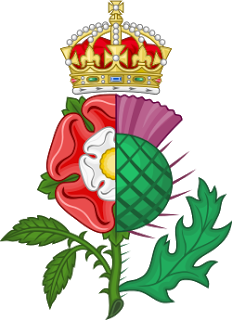 James VI of Scotland was crowned King James of England in Westminster Abbey on July 25, 1603. His wife, Anne of Denmark, was also crowned, but she would not receive Anglican communion since she was a Catholic convert. John Whitgift, the Archbishop of Canterbury, presided over the ceremony. Because of plague in London, there was no procession from the Tower to the Abbey, and the coronation party left London for Winchester on July 26.
James VI of Scotland was crowned King James of England in Westminster Abbey on July 25, 1603. His wife, Anne of Denmark, was also crowned, but she would not receive Anglican communion since she was a Catholic convert. John Whitgift, the Archbishop of Canterbury, presided over the ceremony. Because of plague in London, there was no procession from the Tower to the Abbey, and the coronation party left London for Winchester on July 26.In addition to the royal marriage celebrated on July 25, 1554 and this coronation on the same date in 1603, there is another royal event on July 25. In 1593, according to the Catholic Encyclopedia, Henri Bourbon, King Henri IV of France was received into the Catholic Church at the great Basilica of Saint-Denis, north of Paris, after abjuring Protestantism in the presence of Renaud de Beaune de Semblançay, Archbishop of Bourges and Grand Almoner of France and going to Confession. Elizabeth I, who had been supporting the Huguenots against the Catholic Valois monarchs and their allies of the House of Guise, was rather upset, but Henri reportedly commented that "Paris vaut bien une messe"--and was crowned at the Cathedral in Chartres (not at Reims) in 1594.
Image credit. The badge of the Tudor Rose and the Scottish thistle symbolizes how James VI and I united the kingdoms of England and Scotland in his person, if not officially.
Published on July 24, 2013 23:00
A July Wedding in 1554--and Christmas in July
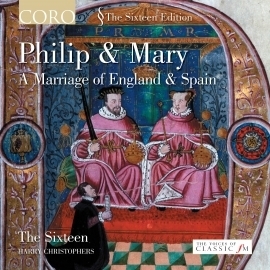 Queen Mary of England and Wales married King Philip of Naples and Jerusalem at Winchester Cathedral on July 25, 1554. This website provides official details of the ceremony and event:
Queen Mary of England and Wales married King Philip of Naples and Jerusalem at Winchester Cathedral on July 25, 1554. This website provides official details of the ceremony and event:First, the said chnrch was richly hanged with arras and cloth of gold, and in the midst of the church, from the west door unto the rood, was a scaffold erected of timber, at the end whereof was raised a mount, covered all with red say, and underneath the roode-loft were erected two traverses, one for the queen on the right hand, and the other for the prince on the left, which places served very well for the purpose. The quire was allso richly hanged with cloth of gold, and on each side of the altar were other two rich traverses as aforesaid, for the queenes majestie and prince.
The queen made her entry into the city of Winchester very richly in apparell, on saturday the 21st of July, and was lodged in the bishop's palace, and prince Philip made his entry into the said city on munday after, being the 23d of July; at whose entry the mayor delivered him the keys of the city, which he received, and delivered them back again, being lodged at the dean's house.
On wensday the 25th of July, being St. James's day, the prince, richly apparelled in cloth of gold, embroidered, [1] with a great company of the nobles of Spayne, in such sort as the like hath not been seen, proceded to the church, and entered in at the west door, and passed to his traverse, all the way on foot; and to the church he had no sword borne before him.
Then came the queenes majesty, accompanied with a great number of the nobility of the realm, the sword being borne before her by the earl of Derby, and a great company of ladyes and gentlewomen very richly apparelled; her majesty's train was borne up by the marquesse of Winchester, [2] assisted by sir John Gage her lord chamberlayne; and so she proceeded to the church; the kinges and herauldes of arms in their coates going before her from her lodging on foot to the church, where entering at the west door she passed on till she came to her traverse. Then the bishop of Winchester, lord chancellor of England, which did the divine service, assisted by the bishopes of London, Duresme, Chichester, Lyncoln, and Ely, all with their crosiers borne before them, came out of the quier to the mount.
Read the rest here.
The illustration is the CD cover of The Sixteen's Philip & Mary - A Marriage of England & Spain including music by Thomas Tallis, Francisco Guerrero, John Sheppard, Pierre de Manchicourt, purporting to document the Mass celebrated on Christmas Day later that year, when Mary was thought to be pregnant:
On Christmas Day 1554 the Spanish Armada was a long way off on the horizon. Mary Tudor had married Prince Philip of Spain, and in celebration of her pregnancy Tallis had composed the Mass Puer natus, which may well have been performed in St Paul's Cathedral on this special day. For this splendid ceremony the English Chapel Royal and choir of St Paul's were joined by Prince Philip of Spain's Capilla Flamenca to sing music by great composers from both countries. This recording presents a number of works which were likely to have been performed by these choirs on this special occasion.
In due time it had to be accepted that the Queen had suffered a phantom pregnancy. Three years later Philip was King of Spain; Mary died the following year.
Track listing:
Pierre De Manchicourt (c.1510-1558)
1. Jubilate Deo
John Sheppard (c.1500-1558)
2. Reges Tharsis
Pierre De Manchicourt
3. Reges terrae
Thomas Tallis (c.1505-1585)
4. Suscipe quaeso
Francisco Guerrero (1528-1599)
5. Ave virgo sanctissima
6. Ave Maria
7. Pastores loquebantur
Thomas Tallis: Mass 'Puer Natus'
8. Gloria
9. Sanctus
10. Benedictus
11. Agnus Dei
John Sheppard
12. Libera nos
Published on July 24, 2013 22:30
July 23, 2013
The Bridgettines and England
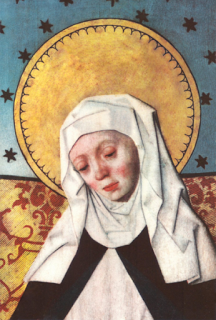 Yesterday was the feast of St. Bridget of Sweden and
The Catholic Herald
reminds us of her legacy, particularly of the Bridgettine order:
Yesterday was the feast of St. Bridget of Sweden and
The Catholic Herald
reminds us of her legacy, particularly of the Bridgettine order:One of six patron saints of Europe and the most celebrated of Sweden’s saints, Bridget was the daughter of a wealthy landowner and related to the royal family. Born in 1303 and married at 13, six of her eight children survived infancy – an unusually lucky family life at a time when most children did not reach their fifth birthday.
However, in 1344, three years after they had gone on pilgrimage together to Santiago de Compostela, her husband Ulf died, after which Bridget, who had always been known for her works of charity, devoted her life to caring for the poor and sick, joining the Third Order of St Francis.
Her most important legacy was the establishment of the Bridgettines, double monasteries under which the nuns were strictly enclosed, emphasising scholarship and study, but the monks were preachers and itinerant missionaries. . . .
In England Richard Reynolds, a monk of the Syon Abbey Bridgittine monastery, became one of the first martyrs of England in 1535.
Bridget’s famous prayer, known as the Fifteen Os , was also tremendously popular in England, and was said to have been inspired after she prayed to know how many blows Jesus Christ suffered during the Passion. He came to her and told her to recite 15 Our Fathers and 15 Hail Marys “with the following Prayers, which I Myself shall teach you, for an entire year”.
The Bridgettine community in England provides this background on Syon Abbey and its martyr, who was called the 'Angel of Syon' even before his execution:
'The Monastery of St. Saviour and St. Bridget of Syon' was a royal foundation, and the only Bridgettine Abbey to be established in England before the Reformation. It was originally built by King Henry V in 1415 on a site in Twickenham opposite his own royal palace at Shene (Richmond), but rebuilt at Isleworth on the banks of the River Thames on the site of an earlier Celestine monastery, first coming into use as a monastery in 1431. Today a newer house on the site, called Syon House, belongs to the Duke of Northumberland. In 2003 excavations were carried out and it was discovered that the abbey church may have been considerably bigger than even Westminster Abbey and would have been an amazing sight from the river. It was a monastery that combined strict observance and practices, modelled on the rule of Saint Augustine and as adapted by Saint Bridget. It was also a centre of learning, the library having contained about 1,400 texts. The foundation consisted of two communities to form a 'double' monastery, in one sixty sisters, in the other thirteen priests, four deacons and eight lay brothers. The monastery flourished until its dissolution by King Henry VIII in 1539. Four years earlier, on 4 May 1535, the 'confessor general' of the Abbey, St. Richard Reynolds, "the Angel of Syon", was brutally executed at Tyburn for not accepting the King's supremacy over the Church in England in place of the Holy Father in Rome. A plaque commemorating him is found today on the wall of one of Syon House's outbuildings. The body of this Bridgettine martyr and canonised saint was placed on the abbey gateway, of which the metre-high carved pinnacle still survives today. This, and the iron cross that once stood on top of the abbey church, are now in the possession of the few remaining enclosed nuns that derive from this first old community who were exiled in the 16thcentury.
Image source: licensed image in wikipedia commons.
Published on July 23, 2013 22:30
July 22, 2013
Henry VIII's Niece, Lady Margaret Douglas, in "History Today"
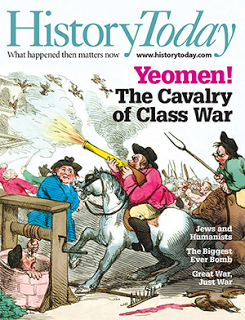 Leanda de Lisle has published an article on Lady Margaret Douglas, Henry VIII's niece (his elder sister Margaret's daughter) in the August issue of History Today:
Leanda de Lisle has published an article on Lady Margaret Douglas, Henry VIII's niece (his elder sister Margaret's daughter) in the August issue of History Today:Lady Margaret Douglas, a favourite of Henry VIII, negotiated the shady politics and shifting alliances of the courts of four Tudor monarchs. Leanda de Lisle tells the story of the ‘progenitor of princes’, whose grandson, James VI of Scotland, became the first Stuart king of England.
Henry VIII ordered a dress from his Great Wardrobe for ‘our niece’, Lady Margaret Douglas, to welcome her arrival at court in April 1530. The 14-year-old princess was destined to be a player in key events over four Tudor reigns. Her youthful romances would see her caught up in the fall of two of Henry’s queens, she would be arrested at least four times, imprisoned in the Tower twice and plot – ultimately successfully – for her heirs to inherit Elizabeth I’s throne. In Margaret’s will of 1578 she still remembered her uncle fondly, listing a picture of Henry among her treasured possessions. Yet her dramatic life story and dynastic significance has been obscured by the story of a quarrel between them that never was.
Margaret Douglas was the child of Henry’s elder sister, Margaret Tudor (1489-1541), Queen of Scots by her second husband Archibald Douglas, Earl of Angus. As such she was third in line to the English throne in 1530, following her elder half-brother, the 16-year-old James V of Scots, and Henry’s daughter, Mary Tudor, who was four months her junior. Her parents’ unhappy marriage had been annulled in 1527. The following year her father sought to flee his step-son, who hated him. Archibald had kidnapped Margaret and sent her to Henry as a goodwill gesture, hoping to gain free passage to England in return.
Read the rest here.
Published on July 22, 2013 22:30
July 21, 2013
Marriage and Succession in the House of Windsor

Queen Elizabeth II is ready for her summer holiday at Balmoral and there were news reports last week that she hopes her grandson William's baby comes soon, because she's leaving per the schedule whether the baby had arrived or not (the Duchess of Cambridge is in labor as of Monday, July 22):
It seems Queen Elizabeth II is getting a bit impatient as she waits in a rare British heat wave for the birth of her third great-grandchild. The queen said Wednesday she hopes the former Kate Middleton gives birth soon. Asked by a schoolgirl at a public event whether she was hoping for a boy or a girl, the queen said, "I don't think I mind. I would very much like it to arrive. I'm going on holiday." The queen is shortly expected to begin her annual summer holiday in Scotland. Prince William and his wife are expecting the birth of their first child, who will be third in line to the throne. The baby is due in mid-July. William and Kate say they do not know the baby's gender.
There were also news reports last week that Queen Elizabeth II had signed the law passed by Parliament legalizing so-called same-sex marriage:
With little fanfare or controversy, Britain announced Wednesday that Queen Elizabeth II -- hardly a social radical -- had signed into law a bill legalizing same-sex marriages in England and Wales. . . . .
Official word that the queen had approved the bill drew cheers in the usually sedate House of Commons. [Has that reporter not seen the Prime Minister facing questions in the House of Commons? "Usually sedate"?]
Queen Elizabeth II may not be a social radical, but she has struck at the root of royal succession by approving such a law. She has also forecasted the continued decline of the Church of England as a leader of society. As the Supreme Governor of the Church of England and the Defender of the Faith, Queen Elizabeth II has indeed pulled the three legs of religious authority out from under the Church of England--Scripture, Tradition, and Reason (not that it wasn't already horribly wobbly).
Scripture and Tradition, and even The Book of Common Prayer, have always and everywhere defined marriage as between a man and a woman--so she has ignored that authority.
She cannot have thought this through--royal succession has always depended on the marital virtue of the man and woman procreating the heir (at least when they were procreating the heir) so that the legitimacy of the heir was certain and absolute. With so-called same sex marriage, that assurance is gone; since reason assures us that two men or two women cannot conceive a child according to nature. A royal same sex "married" couple producing an heir must resort to some form of surrogacy.
She might as well go on holiday--and stay there. Thank God, again, for the Anglican Ordinariate. Our Lady of Walsingham, pray for us.
Published on July 21, 2013 23:30
Becoming Jane Austen, 21st Century Style
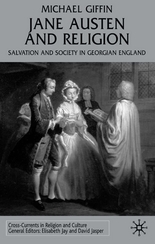 From The Wall Street Journal, Joy Y. Wang writes about her attempt at time travel, including wearing clothing from Jane Austen's era:
From The Wall Street Journal, Joy Y. Wang writes about her attempt at time travel, including wearing clothing from Jane Austen's era:IT IS A TRUTH universally acknowledged that a single man in possession of a spare room must be in want of a lodger.
That was the case, at least, with the room in London I booked through the home-rental website Airbnb. My host was an attractive 33-year-old Australian solicitor, and for a spell I imagined a romance playing out like a Jane Austen plotline.
I've been an Austen devotee since first reading "Pride and Prejudice" at the age of 15, and my milestone birthday felt like the right time to explore a country I'd read about extensively but never visited. I'd see if the mineral waters of Bath could cure me of too many hours spent in front of a computer screen and too few spent at the gym. Perhaps a visit to Jane Austen's house in the village of Chawton, where she lived when "Pride and Prejudice" was first published 200 years ago, would fire up my writerly ambitions. I would wander the grounds of Chatsworth, the grand estate in Derbyshire that is thought to have inspired Austen's description of Pemberley in "Pride and Prejudice."
Read the rest here.
The word "devotee" intrigues and puzzles me. Merriam-Webster's on-line dictionary defines "devotee" as being "an ardent follower, supporter, or enthusiast (as of a religion, art form, or sport)". I am not a devotee of Jane Austen: I am a reader of Jane Austen; I have written about Jane Austen (I wrote my M.A. thesis on "Jane Austen's Persuasion and Hugh Blair's Rhetoric"); I appreciate Jane Austen's art and ability; I enjoy watching adaptations of Jane Austen's works--but I am not "ardent follower, supporter, or enthusiast". I will stipulate that I am odd, but I don't think that Austen needs me to follow, support, or enthuse about her.
On the other hand, the question of Jane Austen as "an ardent follower, supporter, or enthusiast" of Christianity is a topic seldom addressed in criticism of her work, because, as this author notes, her works seem so secular and her clerical characters are so often mocked. Yet, he concludes his analysis of religion in her works in the context of her age:
I read Jane Austen’s novels against a “long eighteenth century” in which Austen firmly stood; against the intellectual prisms that dominated the period—neoclassical hermeneutics, British Empiricism, and Georgian Anglicanism; and against the pervasive and unrelenting reality of unregulated capitalism. My reading does not seek to make theological that which is not theology; but it does seek to make religious that which, for too long, has been misunderstood as secular. In Austen’s world, religious issues are indivisible from secular issues; and religious observance still has a public importance and is not a matter of private observance or psychological journey as it is now considered to be.
If we have become so dedicated to understanding Austen’s novels in the context of their period, then recognizing the unity of Austen’s social and religious vision, whether we choose to believe in it or not, is an urgent critical task. Austen is a Christian humanist who belongs to the neoclassical Enlightenment. She is not a secular humanist whose work can be appropriated to validate the post-Enlightenment critique of the traditional western and Christian world-view. Austen may be a feminist and a capitalist but she is also an Anglican who writes Christian stories. If we—her readers, biographers, and literary critics—fail to grasp the centrality of that fact, and do not rise to the challenge that it presents to reading, biography, criticism, then we will misunderstand her life and misread her novels at their most profound level of interpretation.
Michael Giffen has written a book about Jane Austen and religion, titled Jane Austen and Religion: Salvation and Society in Georgian England, available from Palgrave Macmillan in the UK (Print on Demand):
Jane Austen is often thought of as a secular author, because religion seems absent from her novels, because she satirises her clerical characters, and because history and literacy criticism - and the literary sensibility of the twenty-first century reader - is overwhelmingly secular. Michael Giffin offers a reading of Austen's published novels against the background of a 'long eighteenth century' that stretched from the Restoration to the end of the Georgian period. He demonstrates that Austen is a neoclassical author of the Enlightenment who writes through the twin prisms of British Empiricism and Georgian Anglicanism. His focus is on how Austen's novels mirror a belief in natural law and natural order; and how they reflect John Locke's theory of knowledge through reason, revelation and reflection on experience. His reading suggests there is a thread of neoclassical philosophy and theology running through and between each of Austen's novels, which is best understood in its cultural context.
Published on July 21, 2013 23:00
St. Philip Evans, SJ and St. John Lloyd--334 Years Ago Today
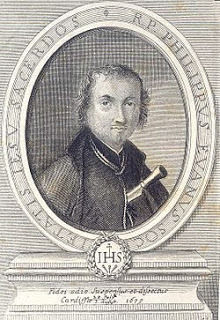 Father Philip Evans, SJ and Father John Lloyd suffered martyrdom on July 22, 1679 in Cardiff, Wales. Although they were tried for supposed involvement in the Popish Plot, they were found guilty of their priesthood and their presence in Wales. This blog provides some detail about their background and contains this great understatement: "1678 was a bad year to be a Roman Catholic priest on the island of Great Britain. (There were many such years in in the 1600s.) But, in 1678, there was a fictional plot by Roman Catholic to assassinate King Charles II. (This was ironic, given the Roman Catholic sympathies of the House of Stuart.) Anyway, a wave of anti-Roman Catholic hysteria swept the land,where authorities political and religious had planted, watered, and nurtured anti-Roman Catholicism for a long time. And hysterical people did not check facts, to confirm or refute them. So the two priest-martyrs became prisoners. They became casualties of hysteria and religious bigotry. Their crime was to be priests, a charge considered on par with committing treason." As the site summarizes their careers: St. Philip Evans, educated at St. Omer Monastery in France, became a Jesuit in 1665, at age 20. Ten years later, at Liege, he entered the priesthood then embarked for his Welsh mission. For three years Evans ministered there.
Father Philip Evans, SJ and Father John Lloyd suffered martyrdom on July 22, 1679 in Cardiff, Wales. Although they were tried for supposed involvement in the Popish Plot, they were found guilty of their priesthood and their presence in Wales. This blog provides some detail about their background and contains this great understatement: "1678 was a bad year to be a Roman Catholic priest on the island of Great Britain. (There were many such years in in the 1600s.) But, in 1678, there was a fictional plot by Roman Catholic to assassinate King Charles II. (This was ironic, given the Roman Catholic sympathies of the House of Stuart.) Anyway, a wave of anti-Roman Catholic hysteria swept the land,where authorities political and religious had planted, watered, and nurtured anti-Roman Catholicism for a long time. And hysterical people did not check facts, to confirm or refute them. So the two priest-martyrs became prisoners. They became casualties of hysteria and religious bigotry. Their crime was to be priests, a charge considered on par with committing treason." As the site summarizes their careers: St. Philip Evans, educated at St. Omer Monastery in France, became a Jesuit in 1665, at age 20. Ten years later, at Liege, he entered the priesthood then embarked for his Welsh mission. For three years Evans ministered there.St. John Lloyd, educated at Ghent (now in Belgium, but a Hapsburg domain) and at Valladolid, Spain (also a Hapsburg domain at the the time). Ordained at Valladolid in 1653, he began this twenty-four-year long Welsh mission the following year.
Among the priests who suffered during the Popish Plot hysteria, St. John Lloyd's long tenure as a missionary priest is not unusual: St. John Kemble served his flock in Monmouthshire for more than 50--fifty--years! and St. David Lewis, SJ served in Wales for 30 years. Pope Paul VI canonized today's martyrs (and John Kemble and David Lewis) among the Forty Martyrs of England and Wales in 1970. Since today is the feast of St. Mary Magdalen, their feast is usually observed--in parishes named for them, for instance, on July 23.
Published on July 21, 2013 22:30
July 20, 2013
Ampleforth Beer, There and Back Again

The Northern Echo has this story about Ampleforth Abbey shipping its beer to France, and how that is a "homecoming" of sorts for the beer:
IN A turn of events which has taken 220 year to come full circle; English monks are to sell beer to the French based on a secret recipe they fled France with way back in 1793.
The secret recipe for “la biere anglaise” has been hopping the channel with Benedictine monks for more than 400 years.
The closely guarded monastic recipe went with them after they were driven from England to France during the Reformation in 1608 before returning to England when they fled Revolutionary France in 1793.
While living on the continent, the beer provided the monks with a living but production ceased on their return to England and wasn't brewed again until last year.
Since Ampleforth Abbey Beer went on sale 12 months ago, the ale has received an enthusiastic reception.
Deliciously Yorkshire named it “Yorkshire’s Best Drink”. Now - in a case of history repeating itself - the French are about to discover the drink again.
Ampleforth Abbey, near Helmsley, has just received a large order for thousands of bottles of its beer from one of France’s leading beer distributors, International Breweries and Beers (IBB).
As soon as I read that second paragraph I began to wonder--"they were driven from England to France during the Reformation in 1608"? The Dissolution of the Monasteries, as we know, occurred during the reign of Henry VIII, not the reign of James I of England. I think what's missing from the timeline is that in 1607, the last link to the Benedictine Abbey at Westminster, re-established by Queen Mary I and then dissolved again by Elizabeth I, the monk Robert Sigebert Buckley, "professed a group of English monks in France, and so passed onto them the rights and privileges of the ancient English Benedictine Congregation", as the Ampleforth Abbey website history page explains. There are more resources about Father Buckley here, including information about the last Catholic Abbot of Westminster, John Feckenham. Among the monks who joined the continued English Benedictine line were the martyr St. Alban Roe and Father Augustine Baker.
Like the English Benedictines of Cambrai who were imprisoned with the Carmelites of Compiegne, the English Benedictines in France at Dieulou
Image credit to wikipedia commons under a license.
Published on July 20, 2013 22:30
July 19, 2013
Pope Leo XIII, RIP
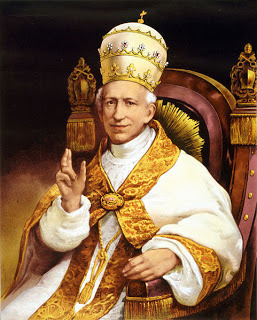 Pope Leo XIII died on July 20, 1903. He was born Gioacchino Vincenzo Raffaele Luigi on March 2, 1810 and elected as the Vicar of Christ on February 20, 1878. As this article from the Catholic Encyclopedia describes his papacy, he had great impact on the Catholic Church in England and left an important legacy for the universal Catholic Church with his many (12!) encyclicals on the Rosary, his ground-breaking social encyclical, Rerum Novarum, and other Catholic devotions, like the Prayer to St. Michael the Archangel:
Pope Leo XIII died on July 20, 1903. He was born Gioacchino Vincenzo Raffaele Luigi on March 2, 1810 and elected as the Vicar of Christ on February 20, 1878. As this article from the Catholic Encyclopedia describes his papacy, he had great impact on the Catholic Church in England and left an important legacy for the universal Catholic Church with his many (12!) encyclicals on the Rosary, his ground-breaking social encyclical, Rerum Novarum, and other Catholic devotions, like the Prayer to St. Michael the Archangel:Saint Michael the Archangel,
defend us in battle;
be our protection against the wickedness and snares of the devil.
May God rebuke him, we humbly pray:
and do thou, O Prince of the heavenly host,
by the power of God,
thrust into hell Satan and all the evil spirits
who prowl about the world seeking the ruin of souls.
Amen.
Sancte Michael Archangele,
defende nos in proelio;
contra nequitiam et insidias diaboli esto praesidium.
Imperet illi Deus, supplices deprecamur:
tuque, Princeps militiae Caelestis,
satanam aliosque spiritus malignos,
qui ad perditionem animarum pervagantur in mundo,
divina virtute in infernum detrude.
Amen.
As to his influence on the British Empire and Ireland, the Catholic Encyclopedia article notes:
Among the acts of Leo XIII that affected in a particular way the English-speaking world may be mentioned: for England, the elevation of John Henry Newman to the cardinalate (1879), the "Romanos Pontifices" of 1881 concerning the relations of the hierarchy and the regular clergy, the beatification (1886) of fifty English martyrs, the celebration of the thirteenth centenary of St. Gregory the Great, Apostle of England (1891), the Encyclicals "Ad Anglos" of 1895, on the return to Catholic unity, and the "Apostolicæ Curæ" of 1896, on the non-validity of the Anglican orders. He restored the Scotch hierarchy in 1878, and in 1898 addressed to the Scotch a very touching letter. In English India Pope Leo established the hierarchy in 1886, and regulated there long-standing conflicts with the Portugese authorities. In 1903 King Edward VII paid him a visit at the Vatican. The Irish Church experienced his pastoral solicitude on many occasions. His letter to Archbishop McCabe of Dublin (1881), the elevation of the same prelate to the cardinalate in 1882, the calling of the Irish bishops to Rome in 1885, the decree of the Holy Office (13 April, 1888) on the plan of campaign and boycotting, and the subsequent Encyclical of 24 June, 1888, to the Irish hierarchy represent in part his fatherly concern for the Irish people, however diverse the feelings they aroused at the height of the land agitation.
When Pope Leo XIII made Father John Henry Newman a Cardinal Deacon of the Church, he knew it was a controversial move--he called Newman "my cardinal" and said, "My cardinal! it was not easy, it was not easy. They said he was too liberal, but I had determined to honour the Church in honouring Newman. I always had a cult for him. I am proud that I was able to honour such a man."
May Pope Leo XIII, Gioacchino Vincenzo Raffaele Luigi, rest in the peace of Christ. Image credit from wikipedia commons.
Published on July 19, 2013 23:00
English Titles and American Translations
Leanda de Lisle has a new book forthcoming in the UK and in the USA, but notice the different titles. The US title is much more sensationalistic: Tudor: Passion. Manipulation. Murder. The Story of England's Most Notorious Royal Family vs. TUDOR: The Family Story :
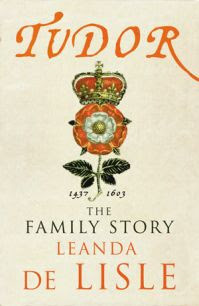
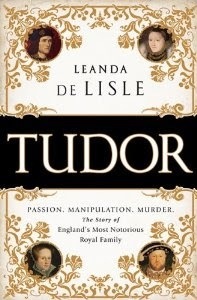
Note, however, that Amazon.com uses the UK title in the book description:
In an epic narrative sweeping from 1437 to the first decade of the seventeenth century, Tudor: the Family Story traces the rise and rule of the Tudor dynasty. Brutal political instability dominated England during this infamous time, and Leanda de Lisle reveals the personalities, passions, and obsessions of the men and women at its epicenter to rediscover the true significances of previously overlooked figures: from the remarkable women, so wholly devoted to securing the line of succession, to the Princes in the Tower, whose disappearances have remained a mystery for centuries.
This groundbreaking story opens at the unlikely beginning of the Tudor dynasty—with Owen Tudor, a handsome Welsh commoner who, with a pirouette and a trip, landed squarely in the lap of the English Monarchy. The struggle of Owen’s grandson Henry VII and his heirs to secure the line of succession—and the hopes, loves, and losses of the claimants—are the focus of this book. The universal appeal of the Tudors also lies in the family stories: of a mother’s love for her son, of the husband who kills his wives, of siblings who betray one another, of reckless love affairs, of rival cousins, of an old spinster whose heirs hope to hurry her to her end.
Thrilling to read and bristling with religious and political intrigue, Tudor: The Family Story tells the true story behind the myths, throwing a fresh, new light on this perennially fascinating era.
Leanda de Lisle has recently started a facebook page, so I posted a message! and I let you know if I get an answer about why the U.S. title uses such strong words: Passion. Manipulation. Murder. Notorious! while the U.K. title refers to the "family story", so domestic and personal.


Note, however, that Amazon.com uses the UK title in the book description:
In an epic narrative sweeping from 1437 to the first decade of the seventeenth century, Tudor: the Family Story traces the rise and rule of the Tudor dynasty. Brutal political instability dominated England during this infamous time, and Leanda de Lisle reveals the personalities, passions, and obsessions of the men and women at its epicenter to rediscover the true significances of previously overlooked figures: from the remarkable women, so wholly devoted to securing the line of succession, to the Princes in the Tower, whose disappearances have remained a mystery for centuries.
This groundbreaking story opens at the unlikely beginning of the Tudor dynasty—with Owen Tudor, a handsome Welsh commoner who, with a pirouette and a trip, landed squarely in the lap of the English Monarchy. The struggle of Owen’s grandson Henry VII and his heirs to secure the line of succession—and the hopes, loves, and losses of the claimants—are the focus of this book. The universal appeal of the Tudors also lies in the family stories: of a mother’s love for her son, of the husband who kills his wives, of siblings who betray one another, of reckless love affairs, of rival cousins, of an old spinster whose heirs hope to hurry her to her end.
Thrilling to read and bristling with religious and political intrigue, Tudor: The Family Story tells the true story behind the myths, throwing a fresh, new light on this perennially fascinating era.
Leanda de Lisle has recently started a facebook page, so I posted a message! and I let you know if I get an answer about why the U.S. title uses such strong words: Passion. Manipulation. Murder. Notorious! while the U.K. title refers to the "family story", so domestic and personal.
Published on July 19, 2013 22:30



